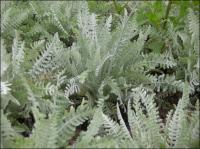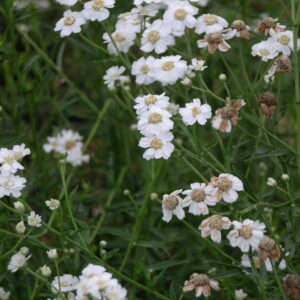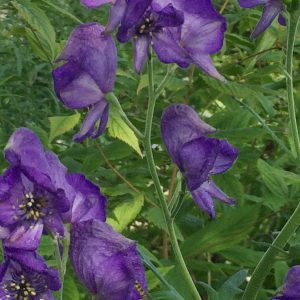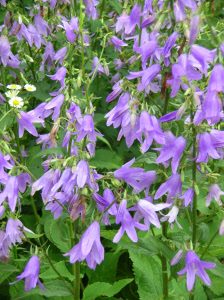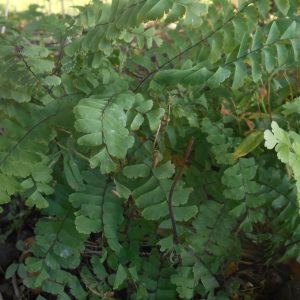Perennials & Biennials
Showing 1–8 of 485 results
-
Acanthus spinosus Bear’s breeches Z 5-9
A WOW plant. Bodacious two-toned spikes of purple & white bracts, June to September. Glossy, deeply incised leaves. Both flowers and leaves terminate in thorny tips.
OUT OF STOCK
A WOW plant. Bodacious two-toned spikes of purple & white bracts, June to September. Glossy, deeply incised leaves. Both flowers and leaves terminate in thorny tips. One of internationally known garden designer Piet Oudolf’s 100 “MUST HAVE” plants, Gardens Illustrated 94 (2013)
LIMITED QUANTITIES AVAILABLE, LIMIT OF 1 PER CUSTOMER PLEASE.
Size: 3-4' x 2-3'
Care: Sun in well-drained soil. Be patient - slow to emerge in spring.
Native: Italy & Turkey
Wildlife Value: Attracts butterflies, Deer and rabbit resistant.The name Acanthus comes from the Greek akantha meaning “thorn” or “thistle” and spinosus means “spine” referring to the thorn on the leaf and flower tips Grown since at least 5thcentury B.C. Inspiration for Corinthian column capital in architecture of ancient Greece and Rome. According to one legend famous Athenian architect and sculptor, Callimachus, 5th century B.C. was charmed upon seeing this plant and adopted it for the top of columns he designed in Corinth. Philip Miller’s 1768 Gardener’s Dictionary, describes this as having “deeply jagged” leaves and “each segment is terminated with a sharp spine, as are also the foot-stalks of the leaves, and the empalement of the flower, which renders it troublesome to handle. . .”
-
Achillea clypeolata Yarrow Z 3-9
Mustard yellow platters in summer on fern-like, thick clumps of gorgeous, silver dissected foliage.
Mustard yellow platters in summer on fern-like, thick clumps of gorgeous, silver dissected foliage.
Size: 18" x 24"
Care: sun in well-drained to moist well-drained soil.
Native: BalkansAchillea named for Achilles, hero of Homer’s Illiad, who used Achillea millefolium to stop bleeding of his wounded soldiers. Clypeolata means “with a shield.” Described in 1813 in Fl. Graec. Prodr. 2: 193 (1813) giving credit to French botanist Joseph Tournefort (1656-1708.)
-
Achillea filipendulina Fernleaf Yarrow Z 3-10
June-July mustard yellow platters on erect stems. Good dried flowers.
June-July mustard yellow platters on erect stems. Good dried flowers.
Size: 3’-4’ x 30”
Care: Full sun in well-drained to moist-well-drained soil. Heat and drought tolerant
Native: Caucasus, Iran, Afganistan.Achillea named for Achilles, hero of Homer’s Iliad, used Achillea millefolium to stop bleeding of his wounded soldiers at the siege of Troy. Achilles learned about the uses of Achillea from Chiron, the Centaur. Introduced to gardens in 1804 when it was sent from the Caucasus to Europe.
-
Achillea ptarmica ‘The Pearl’ Sneezewort, Shirtbuttons Z 3-9
Spring - summer frilly, white “shirtbuttons”
Spring – summer frilly, white “shirtbuttons”
LIMITED QUANTITES AVAILABLE, LIMIT OF 1 PER CUSTOMER PLEASE.
Size: 12-36”x 24”
Care: Full sun, well-drained to moist well-drained soil.
Native: North temperate regionsPtarmica is Greek for sneeze because this plant used for snuff. English brides carried this at their weddings and called the plant “Seven years’ love.” Cultivated in Europe since the Middle Ages and in the U.S. since the 1700’s. The double form grown in English gardens by 1597. Philip Miller (1768) referred to this as “double Maudlin.” “The Pearl” described in the May 1905 edition of The Garden as “probably giving more satisfaction than any other white-flowered hardy perennial. The Pearl is a pearl indeed.”
-
Achlys triphylla Vanilla leaf, Sweet after death Z 5-9
A foot tall stem holds one large leaf divided into three, fan-shaped leaflets with deeply scalloped edges laying flat like a dinner plate. From spring to mid-summer an erect, white spike, not made of flowers, but made of stamens (the male part of plants that holds pollen) blooms.
OUT OF STOCK
A foot tall stem holds one large leaf divided into three, fan-shaped leaflets with deeply scalloped edges laying flat like a dinner plate. From spring to mid-summer an erect, white spike, not made of flowers, but made of stamens (the male part of plants that holds pollen) blooms.
Size: 8-16" x spreading by roots.
Care: shade to part shade in moist to moist well-drained soil
Native: mountains of the western US and Canadian coast up to nearly 5000’Natives of the Pacific Northwest used this medicinally to treat tuberculosis, cataracts, and induce vomiting, They also washed their hair with it and as an insecticide to repel or kill mosquitos, bedbugs and lice on sheep,
Both common names describe the sweet smell of its dried foliage. Collected by “Archibald Menzies on the west coast of North America.” Menzies (1754-1842) sailed on the Vancouver Expedition collecting many plants in 1787-1788. Cyclopedia or Universal Dictionary of Arts. Sciences, and Literature v. 20, p. (1812) where Sir James Edward Smith described and named it Loentic tripylla means Lion’s-leaf. Tripylla means three fruits. Renamed later. -
Aconitum napellus Monkshood Wolfsbane Z 5-8 POISON
Striking, late summer to fall tall stalks, top third covered with flowers, blue washed purple each topped with a hood, in ancient times like a monks’ hood, today like a sweatshirt’s hoody.
Striking, late summer to fall on the top third of tall stalks, covered with flowers, blue washed purple each topped with a hood, in ancient times like a monks’ hood, today like a sweatshirt’s hoody.
LIMITED QUANTITIES AVAILABLE, LIMIT OF 1 PER CUSTOMER PLEASE.
Size: 2-3’x 12”
Care: part shade, cool, moist soil
Native: Europe
Wildlife Value: Aconitums are unusual. They change sex, which, in turn increases procreation! When first blooming they have a “male phase” of about 5-6 days when pollen is available, and the plant produces more nectar and stronger scent. Then the male parts wither making the pollen available to the female parts. The pollen is toxic to bees so most avoid it leaving more for the female parts, therefore increasing fertilization. However, bees are able to collect nectar without harm. https://botany.one/2019/11/aconitum-offers-bees-more-nectar-to-carry-its-toxic-pollen/ Also deer resistant.
Awards: Elisabeth Carey Miller Botanical Garden Great Plant PicksThe name Aconitum is from the mythical hill Aconitus in Pontica where Hercules fought with Cerberus. The Monkshood reputedly sprang from the jaws of Cerberus, the guard dog of the underworld. Believed to make a potion that helped witches fly. Identified by Dioscorides in De Materica Medica for medicinal use c. 70 A.D. Philip Miller in The Gardener’s Dictionary (1768) wrote that the name Aconitum comes from Greek word for dart “because the Barbarians used to daub their darts therewith.” Used by physicians in 1200’s and to poison wolves: “This Wolf’s bayne of all poisons is the most hastie poison.” Wm. Turner, 1560’s. Called Monkshood due to the shape of each flower like a monk’s hood. Introduced to the new world by John Winthrop in 1631.
-
Adenophora lilifolia Ladybells Z 3-8
Fragrant, flared, drooping bluebells in midsummer, July and August
Fragrant, flared, drooping bluebells in midsummer, July and August
Size: 18" x 12" spreading
Care: full sun to part shade in moist, well-drained soil
Native: central Europe east to SiberiaAdenophora is Greek from aden meaning “gland” and phore meaning “to bear.” Named and renamed many times from 1753. “Fragrant blue flowers, freely borne on a loose pyramidal inflorescence.” H.H. Thomas, 1915. “Well suited for the mixed border.” William Robinson, 1899.
-
Adiantum pedatum Maidenhair fern Z 4-9
Grown for its delicate-appearing leaflets arranged in rows. One of internationally known garden designer Piet Oudolf’s 100 “MUST HAVE” plants, Gardens Illustrated 94 (2013)
Grown for its delicate-appearing leaflets arranged in rows. One of internationally known garden designer Piet Oudolf’s 100 “MUST HAVE” plants, Gardens Illustrated 94 (2013)
Size: 12-24”x 12”
Care: Shade in moist to moist, well-drained soil
Native: all parts of No. America including Wisconsin
Awards: England’s Royal Horticultural Society Award of Merit.Cherokee made a tea from this for flu, fever, and rheumatism, paralysis and asthma. Native Americans used stem to make a hair wash and applied a topical poultice of masticated fronds to wounds to stop bleeding. 1st described by French botanist Cornut in 1635. Introduced to gardens in 1635 from Canada where it grew in “such quantities that the French sent it from thence in package for other goods and the apothecaries at Paris use it for (another Maidenhair) in all their compositions in which that is ordered.” Philip Miller (1768). Englishman Tradescant the Younger introduced it to English gardens in 1638 when he sent it from Virginia Colony to London. English herbalist Nicholas Culpepper claimed it as “a good remedy for coughs, asthmas, pleurisy, etc., and on account of being a gentle diauretic, also in jaundice, gravel and other impurities of the kidneys.” (1652). Father of mixed perennial gardens, William Robinson, called this “elegant…unquestionably one of the most distinct and beautiful of the hardy ferns.” The Garden 1876.


